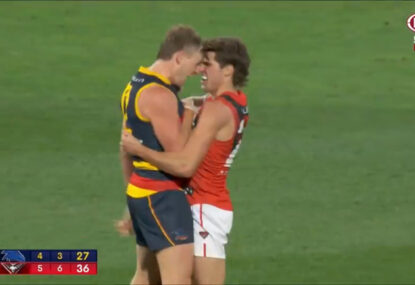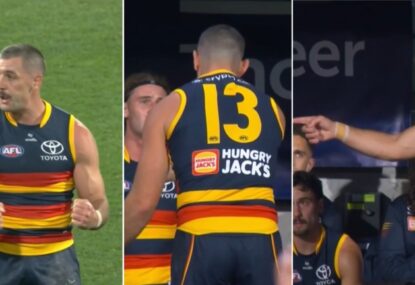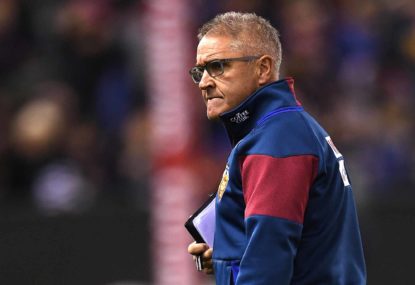Inspired by matth’s brilliant series about alphabetical teams for rugby league and cricket, I have decided to jump into the fray for the first time by throwing together the VFL/AFL equivalent.
After a few weeks of research through the brilliant AFL Tables and australianfootball.com websites, I’m ready for the next challenge of actually writing about the 21 teams.
Some notes before I begin. I am basing my decisions on a player’s VFL/AFL career. Someone such as Russell Ebert, having played the majority of his career in the SANFL, may well make the E team were I to expand the scope but it was already tricky enough to narrow down lists of names from the past and present.
Each letter has its own team, with the exception of I, Q, U, Y and Z. All but U could have had their own (extremely weak) teams with the likes of Adam Inglis (five goals in two games for Carlton circa 1951) but combining them together gives a more representative and quality team. X misses out because Tristan Xerri is yet to debut for North Melbourne.
So without further ado, let’s get to A!
Back line
Marcus Ashcroft (Brisbane, 1989-2003)
318 games, 145 goals
Across a 15-year career, Ashcroft was a tough midfielder-turned-defender who was extremely consistent and courageous. With ten top-ten placements in the club best-and-fairest across 15 years, Ashcroft’s final three years saw him as part of the famous premiership hat trick, after which he retired with a degenerative hip complaint. Ashcroft played 170 games straight at one point, and played the fifth most games in his career without being reported. He is also back pocket in the Queensland team of the century.
David Astbury (Richmond, 2010-)
130 games, nine goals
While it has taken quite some time for Astbury to find his feet as a member of Richmond’s defence, the rise of Richmond has coincided with his own. Early on in his career Astbury suffered shoulder and knee injuries, necessitating long stints on the sideline. But with some continuity at last in 2016 he started to come into his own, ranking highly for intercept possessions and marks. In the 2017 finals series, Astbury kept his opponents to a total of four goals across three games as the Tigers won the flag. In 2019 he went even better, stepping up as defensive leader in the absence of Alex Rance and keeping his opponent Jeremy Finlayson to one possession in the grand final.
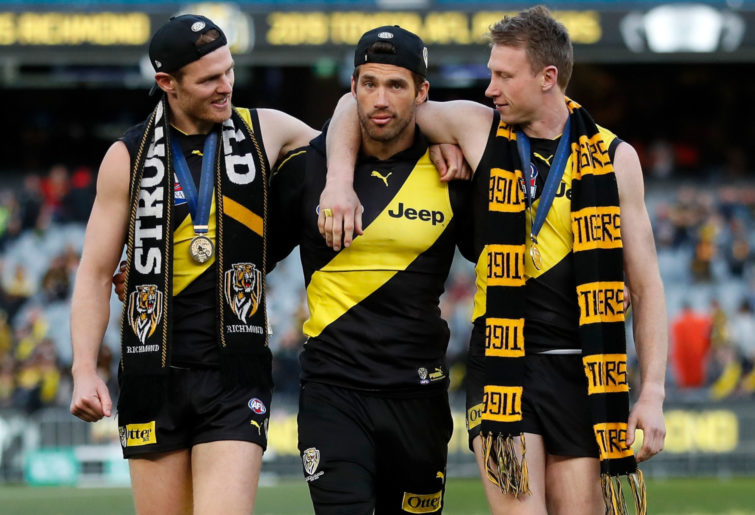
David Astbury (left), Alex Rance (centre) and Dylan Grimes (right) celebrate the 2019 flag. (Photo by Michael Willson/AFL Photos via Getty Images)
Gary Ayres (Hawthorn, 1978-1993)
269 games, 70 goals
‘Conan’ was a pivotal piece of the Hawthorn defence throughout the 1980s and a member of five premiership teams. Winning two Norm Smith Medals (one of only three players to do so), he also won a Hawthorn best-and-fairest in 1986 and represented Victoria in State of Origin in 1984, 1989 and 1990. Described by coach Allan Jeans as “a good driver in heavy traffic”, Ayres kept his head in pressure situations and used his body fearlessly. He was named in the back pocket in Hawthorn’s team of the century.
Halfback line
Col Austen (Hawthorn 1940-49, Richmond 1950-52)
136 games, one goal
Austen, another member of Hawthorn’s team of the century, has gone down in the history books as the Hawks’ first Brownlow Medallist. In fact, he had lost out on count back to South’s Ron Clegg, but in 1989 the league recognised all players who had missed a medal in similar situations. Austen was a dashing flanker who gave no quarter and always competed heavily for the ball, being named as the “personification of rugged tenacity” by umpire Jack McMurray. Following his Brownlow win, Austen left Hawthorn in disgust after his coach Alec Albiston was sacked prior to the 1950 season, and went on to Richmond for three more years.
Ron Andrews (Essendon 1973-83, Collingwood 1984)
157 games, 40 goals
Ronnie Andrews was one of the hard men of the 1970s, missing 24 games through suspension and precipitating the great Windy Hill brawl of 1974. That’s not to say he didn’t have football talent, running second in the Essendon best-and-fairest to Brownlow Medallist Graham Moss in 1976 and representing Victoria in 1977 and ’78. Strong overhead and with an obvious passion for the team, Andrews remained a crowd favourite even after injuries slowed him, and he eventually crossed to Collingwood after missing selection in the 1983 grand final.
Glenn Archer (North Melbourne, 1992-2007)
311 games, 143 goals
One of the most courageous players to pull on a guernsey, Archer started out as a skinny and inconsistent player before bulking up to impose himself on the contest much more. Winning the Norm Smith Medal in 1996, Archer racked up 22 possessions and continually stood in front of Tony Lockett’s leads. For most of his career Archer would go where angels fear to tread, putting his body on the line to repel opposing attacks time and time again. His stature was such that in 2005 he was named the Shinboner of the century as the player most representative of North Melbourne’s ideals. For a brief period he was also the Kangaroos’ games record holder, before being overtaken by Brent Harvey.
Centre line
Geoff Ablett (Hawthorn 1973-1982, Richmond 1983-84, St Kilda 1985)
229 games, 153 goals
Ablett was a pacy wingman who served Hawthorn well for ten years, playing in the 1976 and 1978 premierships. After only seven games in his first year, he became a regular in the side and was noted as one of the fastest players in the competition – a reputation won well by winning the grand final sprint three years running. After 1982, Ablett was cleared to Richmond, where along with St Kilda he had low-key appearances to end his career.
Barry Armstrong (Carlton 1969-81)
204 games, 142 goals
After two games in his debut season, Barry Armstrong spent 12 years at the top of his game with the Blues. Averaging over 22 possessions across his career, Armstrong was an important part of the 1972 and 1979 premierships. While he never won a club best-and-fairest, he finished in the top five in six successive years from 1973 to 1978, also winning best clubman in 1977. Injuries slowed him down in 1981, and he retired after being unable to force his way into the side for the finals after a series of hamstring injuries.
Stan Alves (Melbourne 1965-76, North Melbourne 1977-79)
266 games, 174 goals
As Stan Alves started his career, legendary coach Norm Smith told him to gain a stone in weight before reporting to the club for 1965 preseason training. Alves did so, and went on to become one of the VFL’s most exciting wingmen. Two club best-and-fairests (1972 and 1974), a runner-up position in the 1975 Brownlow Medal, and club captaincy from 1973-76 were to follow. After a falling out with coach Bob Skilton in 1976, Alves joined North on a coin flip and defeated Collingwood – the literal other side of the coin – in the 1977 grand final replay for that elusive premiership.
Ruck line
Steven Alessio (Essendon 1992-2003)
184 games, 193 goals
Steve Alessio inherited the number 27 jumper from Simon Madden after he retired in 1992 and wore it well for the next 11 years. Taking a while to cement his place in the Essendon side (and missing the 1993 premiership), Alessio found his niche as a ruckman who could drift forward to kick the odd goal here or there. He was the starting ruckman in Essendon’s dominant 2000 premiership, and was named as first ruck in the Italian team of the century, as well as in Essendon’s best ever AFL-era team (1990-2015).
Gary Ablett Jr (Geelong 2002-10, 2018-, Gold Coast 2011-17)
346 games, 437 goals
What can be said about Ablett that hasn’t already been mentioned? The raw numbers and accolades alone tell the story: two Brownlows, five AFLPA MVPs, three AFLCA player of the year gongs, eight All Australians, six club best-and-fairests… and that’s just the start of it. To think he started his career as a flashy yet inconsistent half forward! It surely isn’t coincidence that Geelong’s era of dominance started once he was unleashed into the midfield. While on the Gold Coast, his importance was underlined by the fact that once he injured his shoulder in 2014, a Suns team set to enter the finals for the first time won only one game of the remaining seven to fall out of contention. Having returned to Geelong his role in the team has come full circle with more time forward than in the midfield again, but he’s still got it.
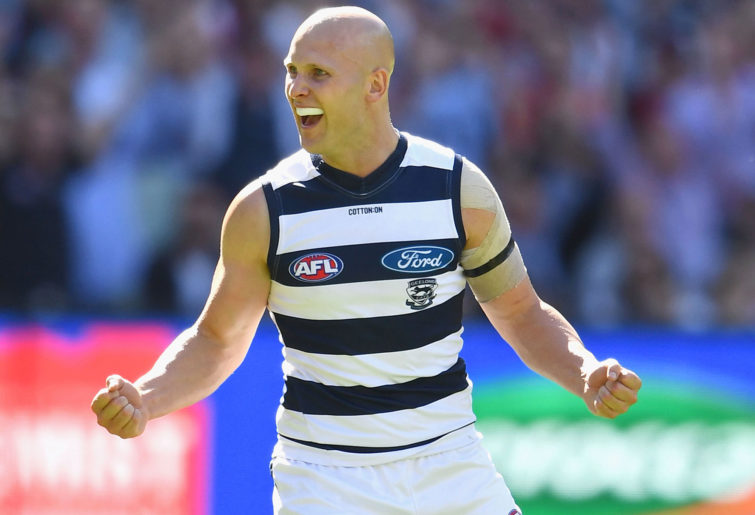
(Quinn Rooney/Getty Images)
Allen Aylett (North Melbourne 1952-64)
220 games, 311 goals
These days Aylett is probably best remembered for his off-field exploits – president of North Melbourne in two stints, VFL president overseeing the relocation of South Melbourne to Sydney – but by the time of his retirement in 1964 he was probably the most decorated Kangaroo to have played. With three straight club best-and-fairests from 1958-60 and representing Victoria 18 times, Aylett was stronger than most rovers of the era, allowing him to win the ball a lot more easily than most of his opponents. Aylett was named in the forward pocket of North’s team of the century.
Half forward line
Jason Akermanis (Brisbane 1995-2006, Western Bulldogs 2007-10)
325 games, 421 goals
If ever the phrase ‘larger than life’ needed personification, it got it in the form of Aker. Brash, bold, and able to back it up, Akermanis started his career in a low-key manner before the arrival of Leigh Matthews as coach rocketed him to stardom. Akermanis won two club best-and-fairests (1999 and 2005) and a Brownlow (2001) while being part of the Brisbane threepeat of 2001, ’02 and ’03. His explosive finishing and elite skills came to the fore late in the 2002 grand final, in particular. After one too many moments of outspokenness, Akermanis was traded to the Dogs where he gave good service before again parting ways with the club mid season.
Lance Arnold (Melbourne 1946-54)
149 games, 88 goals
Lance Arnold was an unobtrusive member of the Melbourne side for nearly a decade before leaving to coach Stawell in the Wimmera League. He was a true swingman, playing centre half forward in the club’s 1948 flag and leading the goal-kicking with 41 majors, before playing centre halfback in the latter part of his career and finishing second in the club best-and-fairest in 1950-51. His final match was the 1954 grand final.
Brett Allison (North Melbourne 1987-1999, Sydney 2000)
228 games, 285 goals
A clever half forward for North over a long period, Brett Allison was frequently able to get either front and centre of a pack or fly over the top, taking mark of the year in 1991. Allison also represented NSW and the Allies in State of Origin matches throughout the 1990s, and was a dual premiership player, winning flags in 1996 and 1999.
Forward line
Alec Albiston (Hawthorn 1936-1949, North Melbourne 1950)
177 games, 389 goals
Albiston was one of the first stars at Hawthorn, the rover coming in for physical punishment on the regular but tough enough to never miss a game through injury. In a poor period for the team, Albiston led the club goal-kicking on four occasions, as well as winning two best-and-fairests in 1941 and 1946. As captain-coach in 1947-49 he had little success and understood that he would no longer be coaching in 1950. However, when new coach Bob McCaskill appointed Kevin Curran to be captain, Albiston split from the club (along with Col Austen as mentioned above) and finished his career at North.
Gary Ablett Sr (Hawthorn 1982, Geelong 1984-97)
248 games, 1031 goals
From a year at Hawthorn, Gary Ablett played six games and kicked nine goals before returning to Myrtleford. Geelong was able to coax him back to the VFL and he promptly responded by winning the club best-and-fairest (interestingly, the only one he won). Thus began the career of the man they call God, seen by many as one of the greatest players of all time. One of only five players to kick 1000 goals, Ablett started his career on the half forward flank or wing, before transitioning to full forward late in his career and winning three straight Coleman Medals in 1993-95. Despite four grand finals, Ablett missed out on a premiership, but did win a Norm Smith Medal for his mesmerising display in 1989. Ablett was named on the half forward flank in Geelong’s team of the century, and the interchange bench of the VFL/AFL team of the century.
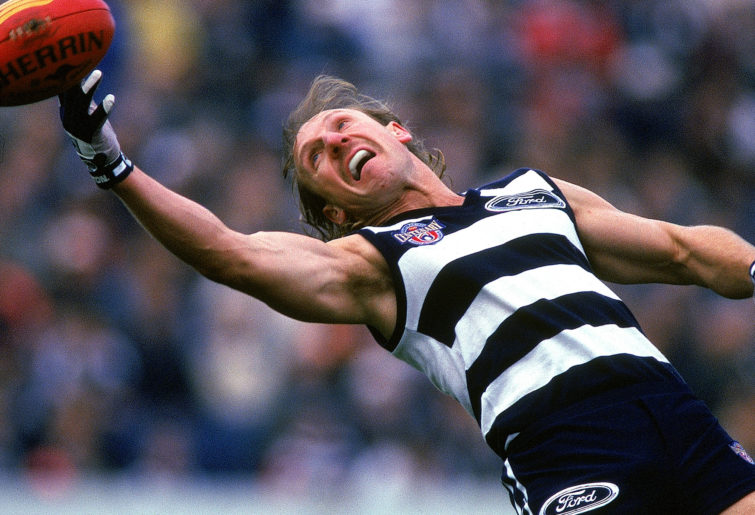
(Photo by Sean Garnsworthy/Getty Images)
Rod Ashman (Carlton 1973-86)
236 games, 370 goals
Part of the famous mosquito fleet at Carlton in the 1970s and ’80s, Rod Ashman was a courageous and skilled rover who overcame early homesickness to be one of the very best. Controversially chasing a clearance to North Melbourne after 1978, Carlton stood firm and were rewarded as Ashman went on to play in the 1981-82 premierships, finishing only one vote behind Bernie Quinlan and Barry Round in the 1981 Brownlow. Injury cruelled the end of his senior career, but he went out on a high by winning the reserves premiership in 1986.
Interchange
Ben Allan (Hawthorn 1990-94, Fremantle 1995-97)
145 games, 106 goals
For a few years Ben Allan was one of the most important players in the Hawthorn midfield after crossing from Claremont, WA. Winning a best-and-fairest in the premiership year of 1991, Allan was primarily a centreman who would gather possessions almost at will, also being named All Australian in 1993 and ’94. Following this, he crossed to the new Fremantle club as their inaugural captain and led the club ably before injuries took their toll.
Simon Atkins (Footscray 1987-94, Fitzroy 1995-96)
168 games, 89 goals
A rugged midfielder partially responsible for Footscray’s rise from almost folding in 1989 to a preliminary final in 1992, Atkins combined well with Brownlow Medallists Scott Wynd and Tony Liberatore without ever reaching the same heights – although he did finish second in the club best-and-fairest twice. Delisted at the end of 1994 and picked up by Fitzroy, Atkins was one of the doomed club’s better performers in their final years.
Les Armstrong (Geelong 1908-20)
175 games, two goals
As a halfback flanker and back pocket for over a decade, Les Armstrong served the Cats well in an early yet difficult period. Armstrong was well renowned for his fairness and durability, playing 91 straight games from 1909-13. Awarded with a life membership of Geelong Football Club two years after his retirement, he is also a member of the club’s hall of fame.
Tom Alvin (Carlton 1984-94)
218 games, 95 goals
While he was probably best known for his shock of hair, Tommy Alvin was a rugged and dependable member of the Blues through the 1980s and 1990s, playing mainly as a halfback or defensive midfielder who had the ability to run the lines when opportunity presented. Besides starring in the 1987 premiership, Alvin was considered one of Carlton’s best in both the 1986 and 1993 grand final losses, and was a regular in the top ten of the club best-and-fairest. He represented Victoria six times.
Emergencies
Frank Adams (Melbourne 1953-64)
164 games, 180 goals
It’s a pity that the late ‘Bluey’ Adams is remembered more for the ten seconds he was on the field in the 1955 grand final than the remainder of his glittering career. As a pacy wingman or rover, Adams was an important part of Melbourne’s side for six premiership teams – one of only two players to be part of all of Melbourne’s successes in the era. He was also a professional sprinter, winning the 1959 Australian sprint title. Adams was named on the interchange bench of Melbourne’s team of the century.
David Armitage (St Kilda 2007-19)
169 games, 98 goals
Armitage was drafted in 2006, and took some time to cement his place in the St Kilda line-up. Once he did so in 2011, he was a fixture in the midfield as a hard nut who could win his own ball. Season 2015 was his best year, standing in as captain for three matches and finishing second in the club best-and-fairest. Injury and concussion combined to end his career at the end of 2019.
Rod Austin (Carlton 1972-85)
220 games, 20 goals
‘Curly’ Austin, so named for his hair, had a distinctive kicking style, which was used often coming out of the defensive 50 in his role as a dour backman. Austin has the rare achievement of keeping Peter Hudson goalless, one of only three players to do so in Hudson’s career. Solid and dependable, Austin rarely lowered his colours in his 14 years. Despite playing in a prosperous period for the Blues, his only premiership was in 1979, missing others through inexperience or injury.
Up next we have the B team, featuring three of the game’s greatest ever centre half forwards and a few modern marvels who would still be playing today if circumstances were different.

































































































